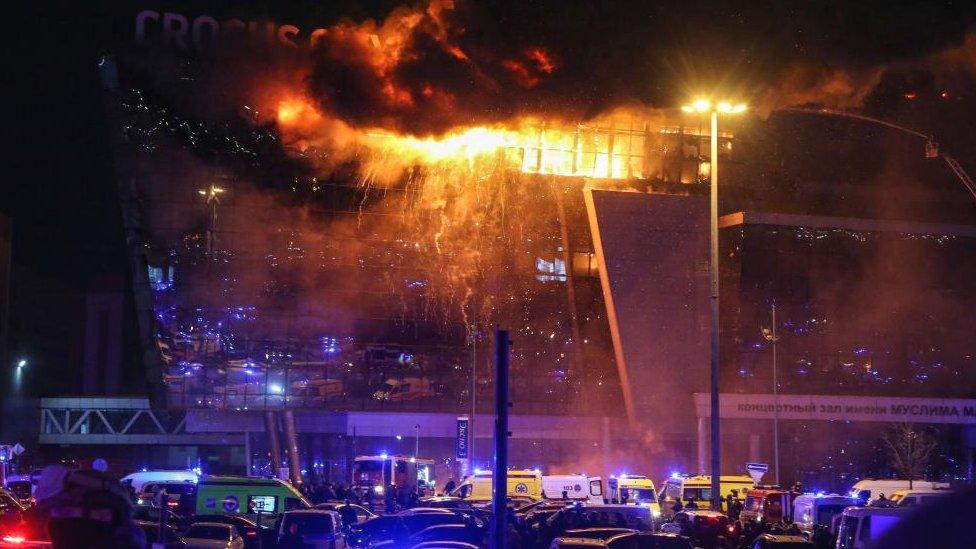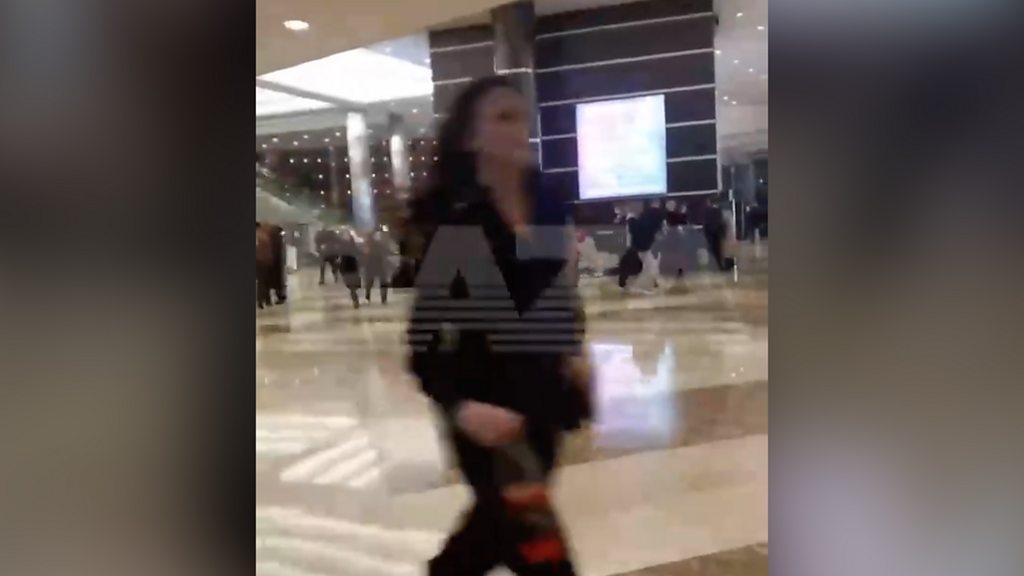What we know about attack on a Moscow concert hall
- Published
Footage shows people taking cover inside the venue as multiple shots are heard
The attack on a Moscow concert hall on 22 March 2024 was the worst in Russia for years. Days after President Vladimir Putin began his fifth term of office, gunmen stormed the complex, killing 145 people and injuring more than 500. The Islamic State group (IS) has said four of its members carried out the attack.
This is what is known so far.
How did the attack unfold?
Crocus City Hall, on the outskirts of Moscow - 20km (12 miles) from the Kremlin - was about to host a concert by the rock group Picnic when gunmen burst into the foyer just after 20:00 (17:00 GMT) on Friday evening.
Video showed at least four people shooting randomly before proceeding into the concert hall itself and opening fire there.
Inside the auditorium, a woman said she and other visitors rushed towards the stage as soon as they realised shots were being fired.
"I saw a person in the stalls with a sidearm and there were cracks [of gunfire] going off, I was trying to crawl behind a loudspeaker," she told Russian TV.
At some point, fire can be seen inside the hall. Flames later engulfed the facade, while glass on the top two floors of the seven-storey building blew out.
"The terrorists used a flammable liquid to set fire to the concert hall's premises, where spectators were located, including wounded," Russia's Investigative Committee said.
Helicopters were brought in to drop about 160 tonnes of water, but it took some 10 hours for the fire to be contained.
By the time the suspects escaped - according to some accounts, the attack lasted about 20 minutes - hundreds had been killed and injured.
Many died from bullet wounds, some as a result of smoke inhalation.
Picnic's band members themselves were unharmed.
Who are the Crocus City Hall victims?
More than 6,000 Russians had flocked to the retail and concert complex for the event.
At least 145 have been confirmed dead - six of them children.
Watch: BBC Verify examines video taken by those caught up in the attack on the Crocus City Hall theatre outside Moscow
Some of the more than 500 people who were injured died of their wounds later in hospital.
Many of those killed and wounded came from Krasnogorsk, Khimki and other nearby towns on Moscow's north-western fringe.
Who are the attackers?
Those who carried out the attack managed to escape the inferno and mayhem they left behind.
Russian MP Alexander Khinshtein said the attackers fled in a white Renault car. According to him, police tried to stop the vehicle in the Bryansk region, about 340km (210 miles) from Moscow, managing to arrest two people as the others fled.
Some 14 hours after the first reports of shooting, Russia's Federal Security Service (FSB) announced 11 people had been arrested.
Four suspects were dragged into a court in Moscow on Sunday, 24 March, and named as Dalerdzhon Mirzoyev, Saidakrami Murodali Rachabalizoda, Shamsidin Fariduni and Muhammadsobir Fayzov.
All were charged with an act of terrorism and probably face life in prison.
All four are originally from Tajikistan.
Who was behind the attack?
In a brief statement on the day of the attack, IS said it was behind the attack. It released a photograph of what it said were the four attackers - all masked.
The group later released highly graphic footage from the attack. The video, verified by the BBC as genuine, shows one of the gunmen opening fire on several people.
Russian authorities have not been too keen to comment on the IS claim, which came two weeks after the US warned of a potential attack targeting "large gatherings" in Moscow. Russian officials have complained the US intelligence lacked specific detail.
In fact, a week before the attack, President Vladimir Putin said: "Recent provocative statements by a number of official Westerns structures about the possibility of terrorist attacks in Russia... resembles outright blackmail and an intention to intimidate and destabilise our society."
The US had singled out Islamic State-Khorasan or IS-K, an offshoot which seeks to establish a Muslim caliphate across Afghanistan, Pakistan, Turkmenistan, Tajikistan, Uzbekistan and Iran.
Colin Clarke, a counterterrorism analyst based in New York, was quoted by the New York Times as saying IS-K had been "fixated" on Russia for the past two years.
He said it "accuses the Kremlin of having Muslim blood in its hands, referencing Moscow's interventions in Afghanistan, Chechnya and Syria".
Instead of commenting on the IS claim, officials have been eager to point the finger at Ukraine - the neighbour Russia has been at war with since it launched a full-scale invasion on 22 February 2022.
"Based on preliminary information, a window for crossing the border was prepared for them by the Ukrainian side," Mr Putin said in the aftermath of the attack.
Ukraine swiftly dismissed the Russian claims as "absolutely untenable and absurd".
But Russian officials have been amplifying the claim, regardless. Russia's state investigative committee alleged that the attack had been financed by funds flowing through a Ukraine-based oil and gas firm, although the company was dissolved in 2023.
BBC Verify has been able to match details of two of the alleged attackers who appear in an IS video and an IS-released still image to videos of the arrested suspects posted on pro-Kremlin Telegram channels.

- Published23 March 2024

- Published23 March 2024
